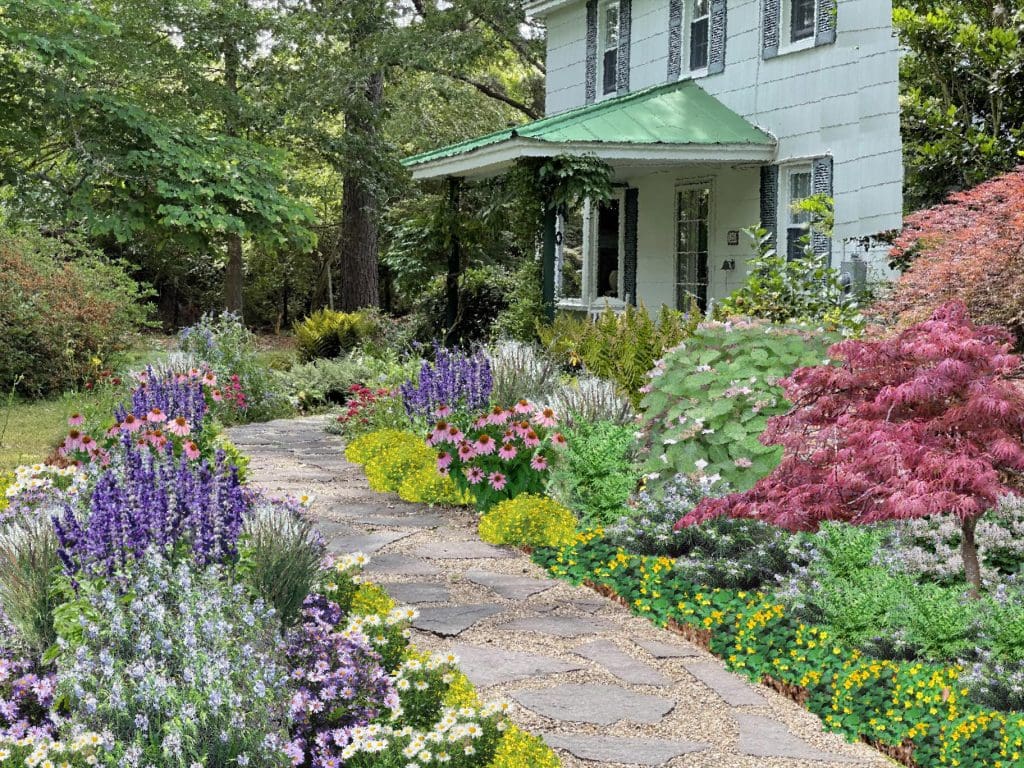The Ultimate Guide To Hilton Head Landscapes
The Ultimate Guide To Hilton Head Landscapes
Blog Article
The Ultimate Guide To Hilton Head Landscapes
Table of ContentsHilton Head Landscapes for BeginnersThe Best Guide To Hilton Head LandscapesFascination About Hilton Head LandscapesThings about Hilton Head LandscapesGetting My Hilton Head Landscapes To Work6 Easy Facts About Hilton Head Landscapes ExplainedThe Of Hilton Head LandscapesWhat Does Hilton Head Landscapes Mean?
Kind compatibility is additionally a significant element of unity in designone or 2 noticeably different kinds are excellent for comparison and emphasis, yet generally all other kinds ought to have some resemblances for a merged appearance. Texture describes just how crude or fine the surface of the plant or hardscape material really feels and/or looks.
Examples of plants with rugged texture consist of philodendrons, agaves, bromeliads, hollies, palms, and hydrangeas. Hardscape with coarse texture consists of rough-cut stone, rough-finished brick, and unfinished timber with knots and an increased grain. Aged or old construction product that preserves a weather-beaten surface area is commonly coarse in appearance. Features that develop fine appearance consist of little vegetation; thin, strappy leaves (grasses) or high, thin stems; little, thick twigs and tiny branches; long stems (creeping plants); and little, delicate flowers.
Some Known Incorrect Statements About Hilton Head Landscapes
Most plants are average appearance, in that they can not be defined as having either crude or fine structure. Medium-textured plants act as a background to link and unify the coarse- and fine-textured plants.

To make an area feel smaller, place the coarse appearances along the outer perimeter and the fine textures closest to the audience. The detail of the coarse appearance makes the plants appear closer and makes the space really feel smaller sized. The viewed appearance of plants can additionally alter with the distance from the plant.
The smart Trick of Hilton Head Landscapes That Nobody is Discussing
Bold colors boost the comparison and make the structure show up coarser, while low-key shades can flatten texture. Hardscape with a crude texturesuch as really harsh rocks and bold, large timberstends to make all plant product appear extra average distinctive. Designers typically establish a structure study (Number 8) theoretically to assist decide the setup of plant products.
Figure 8. Appearance research study. Color in plant material and hardscape adds interest and range to the landscape. Color is one of the most noticeable component in the landscape and is generally the focus of the majority of house owners; nonetheless, it is additionally one of the most momentary aspect, normally lasting only a couple of weeks a year for private plants.
An Unbiased View of Hilton Head Landscapes
A basic summary of the color wheel includes the three main colors of red, blue, and yellow; the three secondary colors (a mix of 2 primaries) of environment-friendly, orange, and violet; and 6 tertiary shades (a mix of one surrounding key and second color), such as red-orange. Color theory discusses the connection of shades to every other and exactly how they ought to be utilized in a structure.

Similar (often called unified) color design are any kind of 3 to 5 shades that are adjacent on the shade wheel, such as red, red-orange, orange, yellow-orange, and yellow, or blue, blue-violet, and violet (landscape design hilton head). The shades belong per other because they usually include 2 primaries blended to form a secondary and two tertiary colors, which means they share typical properties
They tend to have high contrast between them. The most common sets are violet and yellow, red and green, and blue and orange. Corresponding colors are commonly discovered normally in blossoms; a typical pair is yellow and violet. Color is discovered in the blossoms, vegetation, bark, and fruit of plants.
The smart Trick of Hilton Head Landscapes That Nobody is Talking About
Environment-friendly vegetation in all its various tones is the dominant shade by quantity, yet other colors record attention quicker since of their high contrast to the color environment-friendly. Shade is article source also located in buildings, rocks, pavers, timber, and furniture. The majority of colors in all-natural materials, such as rock and timber, are typically low-key and have a tendency to be variants of brown, tan, and pale yellow.
Colors have properties that can influence feelings, spatial assumption, light quality, balance, and focus. Trendy shades tend to be calming and must be used in areas for relaxation and serenity.
The Ultimate Guide To Hilton Head Landscapes
The "temperature level" of colors can also influence the assumption of range. Trendy colors tend to decline and are viewed as being farther away, making an area feel bigger. Cozy colors have a tendency to development and are viewed as being closer, making a room feel smaller sized. Shade can also be made use of to capture focus and straight sights.
As an example, brilliant yellow, which has the highest intensity, also has a high comparison with all other colors (often described as a "pop" of color) and need to be used moderately. A percentage of intense shade has as much aesthetic weight as a large amount of a more suppressed or weaker color.
Similar (in some cases called unified) color pattern are any kind of 3 to five shades that are nearby on the shade wheel, such as red, red-orange, orange, yellow-orange, and yellow, or blue, blue-violet, and violet. The colors are related to every various other due to the fact that they usually consist of 2 key colors mixed to form an additional and 2 tertiary shades, which suggests they share common homes.
What Does Hilton Head Landscapes Do?
They have a tendency to have high contrast between them. The most typical collections are violet and yellow, red and eco-friendly, and blue and orange. Corresponding shades are often located normally in blossoms; an usual pair is yellow and violet. Color is discovered in the flowers, vegetation, bark, and fruit of plants.
Eco-friendly vegetation in all its various tones is the dominant color by quantity, yet other colors record interest quicker due to their high contrast to the shade eco-friendly - landscapers hilton head island - https://www.storeboard.com/hiltonheadlandscapes. Color is likewise located in structures, rocks, pavers, wood, and furnishings. The majority of colors in all-natural materials, such as stone and timber, are commonly soft and tend to be variants of brown, tan, and pale yellow
Excitement About Hilton Head Landscapes
Shades have residential properties that can impact emotions, spatial understanding, light quality, equilibrium, and focus. Great colors often tend to be calming and should be used in areas for relaxation and peacefulness.
The "temperature level" of shades can likewise impact the assumption of range. Trendy colors tend to recede and are regarded as being further away, making an area feel bigger. Cozy colors tend to advancement and are perceived as being closer, making a space feel smaller. Shade can additionally be utilized to record focus and direct views.
Bright yellow, which has the highest possible intensity, also has a high comparison with all various other colors (often defined as a "pop" of color) and ought to be used moderately. A percentage of extreme color has as much visual weight as a big amount of an extra restrained or weaker color.
Report this page